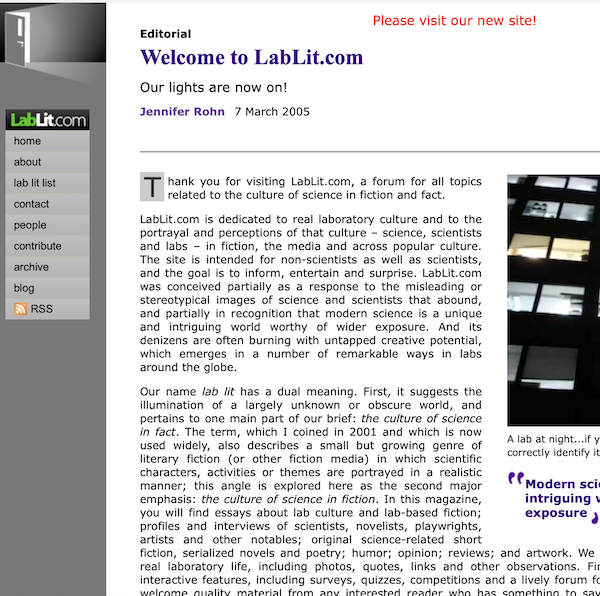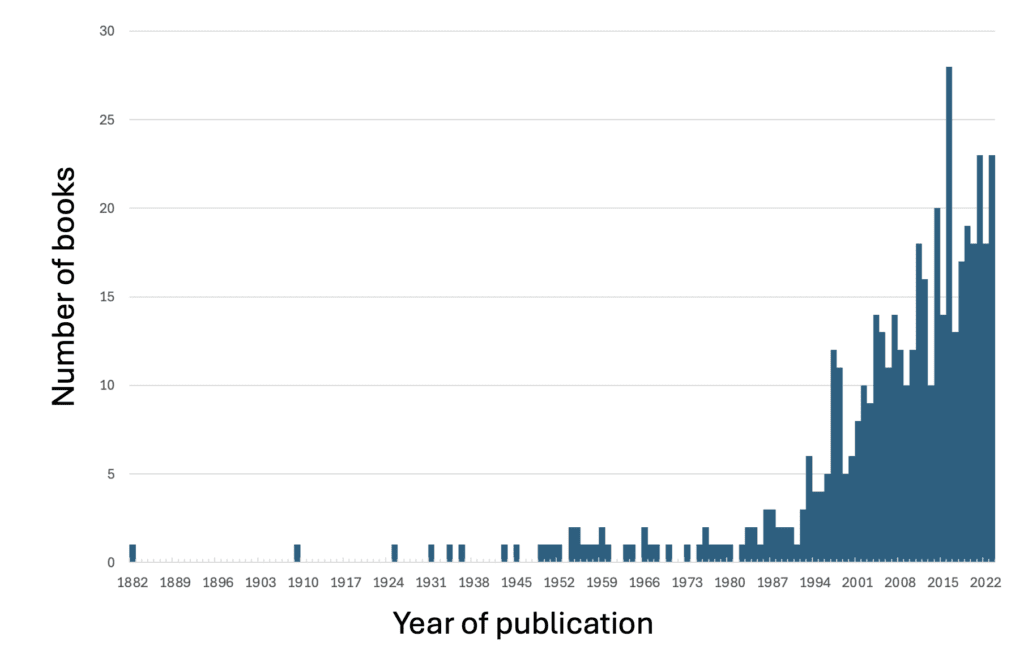It’s been twenty years since our very first article was put live on 7th March 2005.

I’d been mulling over the concept of ‘lab lit’ fiction since I coined the term as a thought experiment back in 2001: fiction about science as a profession, featuring scientists who ply their trade as part of a realistic plot. (You can read more about that journey in a piece I wrote for Nature.) The genre remains vanishingly rare, which has always struck me as odd given how central science is to our daily lives, and given how many millions of people practice it worldwide.
But of course there are obstacles to lab lit that could explain its rareness: the general lack of understanding of what it is we actually do as scientists; the potential complexity of the contextual subject matter; and of course, the fear and distaste many people feel about science – which would include authors and potential readers as well as the literary agents, editors and marketeers who gatekeep what gets published.
So I launched the website in 2005 to try to illuminate both the real-life world of scientists and the fiction that attempts to illustrate it – both existing works, alongside new fiction submitted to the site. As part of this, our Lab Lit List was, and remains, a living, curated database of all such books ever published – alongside other forms of fiction such as plays, television and movies. (The latter categories we freely admit are full of holes, as it’s not our main focus. If you see any missing, do let us know!) It’s been updated today with 30 new works, and by popular demand, alphabetized by author surname – do check it out.
None of this would have been possible without the hard work of our deputy editor, Richard, who keeps the site running smoothly, aids in editing, and also contributes content to the site. Also key are those who have stood by the website for many years – of this wonderful group of people, the Labliterati, more here.
When we launched, the List contained only about a hundred novels; with our latest update published today, that number stands at a whopping 495. This increase is due to two main factors. First, it’s thanks to the kind assistance I’ve had from many readers who have nominated their favorite older works, alongside the tireless sleuthing of our chief “Lab Lit Sniffer”, Dom (read his personal musings on this unusual role here). Dom spends most of his free time scouring published book reviews and nosing around bookshops looking for lab lit novels. In fact, at a recent Fiction Lab pub session, Dom attempted to buy a round of drinks, only to discover that he’d spent all his beer money on books.

But the second reason for the increase is far more exciting. And that is that the number of lab lit novels being written is definitely on the rise. Back in 2010, I published a piece in Nature with a graph suggesting an uptick in the late 1980s – see the image above. But as the numbers might have been plateauing as of 2010, it was really difficult to predict if this trend would continue.

So for this anniversary issue, we decided to revisit the experiment (thanks again to Dom for his hard work compiling the data from 2010 to 2022). As you can see from the above updated graph, the year-on-year increase in lab lit novels is absolutely real. (A big shout out to 2016, which saw the release of a whopping 28 books!) From a norm of no annual publications to perhaps one to two, we have been averaging a steady 16 for the past decade. And the trend very much looks like we can expect a continuing rise in the future.
Much has changed since 2005. The site itself was revamped in 2019, migrating to a fresh new look that worked better on portable devices, and leaving behind the original site as an unconnected archive. (If you want to search pre-2019 content, click on the archive button and you will be taken to the last issue of the old site, where the normal search bar can be used. Searches on the new site will only recover pieces from the post-migration period.) Long-time readers will have noticed that our updates and articles have become far less frequent than in the old days – a reflection of the fact that, in returning to academic research and eventually becoming a professor, my time is increasingly commandeered by teaching, writing papers and grants, travelling to give talks, and just generally trying to survive in the cutthroat profession that lab lit novels seek to convey.
Despite this, I remain fiercely proud of the website, and hope that you all will stay with us for many more years to come. If you’d like to contribute a piece for get involved in any other way, just drop us a note on editorial@lablit.com.
